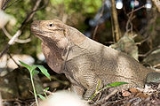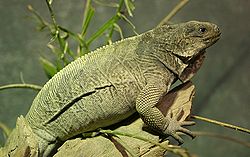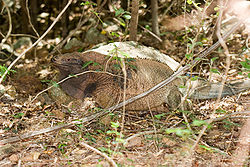
Cyclura pinguis
Encyclopedia
The Stout Iguana or Anegada Ground Iguana (Cyclura pinguis) is a critically endangered species of lizard
of the genus Cyclura
belonging to the Iguanidae
family. The species can be found exclusively in the island of Anegada
. Historically, it inhabited the islands of Puerto Rico
and Saint Thomas
, however the animal's original range has been greatly diminished.
, then onwards to the north and western islands, which has since diversified on different islands into the 9 species and several additional subspecies of the genus Cyclura as we know it today.
1917. Its generic
name (Cyclura
) is derived from the Ancient Greek
cyclos (κύκλος) meaning "circular" and ourá (οὐρά) meaning "tail", after the thick-ringed tail characteristic of all Cyclura iguanas, with the exception of the Anegada rock iguana. Its specific
name pinguis means "fat" and refers to the animal's stocky appearance and the common name "Stout iguana".
Male Anegada iguanas, like other species within the Genus Cyclura, are larger than females, and have more prominent dorsal
crests in addition to prominent femoral pore
s on their thighs, which are used to release pheromones. Females have less prominent pores and have shorter crests than the males making the animals sexually dimorphic
.
 This forced diet has had an impact on the iguanas' ability to reproduce. As reproductive females are not being provided with enough nutrition to produce eggs and support their own metabolism; many do not survive after laying eggs, resulting in the present skewed sex ratio of 2 males to every female. Females usually lay one clutch of about 12-16 eggs per year in late spring or early summer.
This forced diet has had an impact on the iguanas' ability to reproduce. As reproductive females are not being provided with enough nutrition to produce eggs and support their own metabolism; many do not survive after laying eggs, resulting in the present skewed sex ratio of 2 males to every female. Females usually lay one clutch of about 12-16 eggs per year in late spring or early summer.
Anegada Island is rare in that it is not a volcanic island, but formed from coral and limestone providing many caves and natural burrows for the iguanas to live. Animals typically inhabit a single burrow and it was once observed that they appeared to bond for life, dwelling in burrows in close proximity to their mate. As the drive to find more females and compete for food has increased their range, this does not appear to be occurring any longer.
 The primary reason for the Anegeda Ground Iguana's decline is competitive grazing with domestic and feral livestock. The secondary reason is that they are preyed upon by feral dogs and cats. As with other Rock Iguanas, their habitat is also in rapid decline due to development and logging.
The primary reason for the Anegeda Ground Iguana's decline is competitive grazing with domestic and feral livestock. The secondary reason is that they are preyed upon by feral dogs and cats. As with other Rock Iguanas, their habitat is also in rapid decline due to development and logging.
Live Anegada iguanas used to regularly be sold to tourists as pets, as their rarity made them more appealing to exotic animal collectors, despite this being illegal under the CITES treaty. In 1999 a World Wildlife Fund international conservation officer, Stuart Chapman, said: "The British government has turned a blind eye for over 20 years to these overseas territories which are home to many rare and endangered species. Many of these face extinction if Britain fails to honour its treaty obligations. The British Caribbean islands are extremely rich in biodiversity with many critically endangered species
that are unique to the islands - yet there is virtually zero enforcement or implementation of CITES."
In the 1980s, eight iguanas were moved from Anegada to Guana Island
, British Virgin Islands, to start a second population in part of the species' former range. Guana Island is not a limestone island, and does not provide as many natural retreats as Anegada does. The iguanas appear to be doing well and reproducing in areas free of feral sheep, which is its only competitor for vegetation. Approximately 20 adult iguanas are estimated to inhabit Guana and offspring have been seen each year since 1987. Guana Island Wildlife Sanctuary continues to try to rid the island of sheep, which may improve the habitat for iguanas.
The Anegada Rock Iguana has also been successfully bred in captivity at the San Diego Zoo
and the Fort Worth Zoo
. Both zoos have actively been working with the British Virgin Islands on a joint-recovery program started in 1997 on Anegeda Island. 120 iguanas have been raised at the facility for release into the wild. Hatchlings are fed and protected so they can be "headstarted" for the wild and not fall prey to feral
dogs and cats
. This offsets the juvenile mortality rate and is accompanied by field research, nestsite protection, and monitoring of released animals.
Lizard
Lizards are a widespread group of squamate reptiles, with nearly 3800 species, ranging across all continents except Antarctica as well as most oceanic island chains...
of the genus Cyclura
Cyclura
Cyclura is a genus of lizards from the family Iguanidae. Members of this genus are known as "cyclurids" or more commonly as rock iguanas and only occur on islands in the West Indies...
belonging to the Iguanidae
Iguanidae
Iguanidae is a family of lizards, composed of iguanas and related species.-Classification of Iguanidae:Two different classification schemes have been used to define the structure of this family. These are the "traditional" classification and the classification presented by Frost et al. .Frost et...
family. The species can be found exclusively in the island of Anegada
Anegada
Anegada is the northernmost of the British Virgin Islands, a group of islands which form part of the archipelago of the Virgin Islands. It lies approximately north of Virgin Gorda. Anegada is the only inhabited British Virgin Island formed from coral and limestone, rather than being of volcanic...
. Historically, it inhabited the islands of Puerto Rico
Puerto Rico
Puerto Rico , officially the Commonwealth of Puerto Rico , is an unincorporated territory of the United States, located in the northeastern Caribbean, east of the Dominican Republic and west of both the United States Virgin Islands and the British Virgin Islands.Puerto Rico comprises an...
and Saint Thomas
Saint Thomas, U.S. Virgin Islands
Saint Thomas is an island in the Caribbean Sea and with the islands of Saint John, Saint Croix, and Water Island a county and constituent district of the United States Virgin Islands , an unincorporated territory of the United States. Located on the island is the territorial capital and port of...
, however the animal's original range has been greatly diminished.
Natural history
The Anegada iguana is noted as the oldest species of Cyclura and the most genetically divergent of the West Indies' rock iguanas. An ancestor to this iguana first dispersed to HispaniolaHispaniola
Hispaniola is a major island in the Caribbean, containing the two sovereign states of the Dominican Republic and Haiti. The island is located between the islands of Cuba to the west and Puerto Rico to the east, within the hurricane belt...
, then onwards to the north and western islands, which has since diversified on different islands into the 9 species and several additional subspecies of the genus Cyclura as we know it today.
Taxonomy
The Anegada rock iguana, Cyclura pinguis, was first described by American Herpetologist Thomas BarbourThomas Barbour
Thomas Barbour was an American herpetologist. From 1927 until 1946, he was director of the Museum of Comparative Zoology founded in 1859 by Louis Agassiz at Harvard University in Cambridge, Massachusetts....
1917. Its generic
Genus
In biology, a genus is a low-level taxonomic rank used in the biological classification of living and fossil organisms, which is an example of definition by genus and differentia...
name (Cyclura
Cyclura
Cyclura is a genus of lizards from the family Iguanidae. Members of this genus are known as "cyclurids" or more commonly as rock iguanas and only occur on islands in the West Indies...
) is derived from the Ancient Greek
Ancient Greek
Ancient Greek is the stage of the Greek language in the periods spanning the times c. 9th–6th centuries BC, , c. 5th–4th centuries BC , and the c. 3rd century BC – 6th century AD of ancient Greece and the ancient world; being predated in the 2nd millennium BC by Mycenaean Greek...
cyclos (κύκλος) meaning "circular" and ourá (οὐρά) meaning "tail", after the thick-ringed tail characteristic of all Cyclura iguanas, with the exception of the Anegada rock iguana. Its specific
Species
In biology, a species is one of the basic units of biological classification and a taxonomic rank. A species is often defined as a group of organisms capable of interbreeding and producing fertile offspring. While in many cases this definition is adequate, more precise or differing measures are...
name pinguis means "fat" and refers to the animal's stocky appearance and the common name "Stout iguana".
Anatomy and morphology
The Anegada ground iguana is a large heavy-bodied rock iguana which attains a total body length of close to 22 inches(560 mm). As juveniles they are faintly or boldly patterned with wide gray to moss green bands interspersed with wide gray to black anteriorly directed chevrons. These bands fade and are generally lost as the animals mature, turning a uniform grayish or brownish-black with varying amounts of turquoise on the dorsal spines, tail base, fore and hind legs. Occasionally this bluish coloration extends up onto the sides of the individual, particularly in males. Females tend to be relatively dull in color, exhibiting less brilliant blue if any.Male Anegada iguanas, like other species within the Genus Cyclura, are larger than females, and have more prominent dorsal
Dorsum (biology)
In anatomy, the dorsum is the upper side of animals that typically run, fly, or swim in a horizontal position, and the back side of animals that walk upright. In vertebrates the dorsum contains the backbone. The term dorsal refers to anatomical structures that are either situated toward or grow...
crests in addition to prominent femoral pore
Femoral pore
Femoral pores are a part of a holocrine secretory gland found on the inside of the thighs of certain lizards and amphisbaenians which releases pheromones to attract mates or mark territory. In certain species only the male has these pores and in other species, both sexes have them, with the males...
s on their thighs, which are used to release pheromones. Females have less prominent pores and have shorter crests than the males making the animals sexually dimorphic
Sexual dimorphism
Sexual dimorphism is a phenotypic difference between males and females of the same species. Examples of such differences include differences in morphology, ornamentation, and behavior.-Examples:-Ornamentation / coloration:...
.
Diet
Like all Cyclura species the Anegada Ground Iguana is primarily herbivorous, consuming leaves, flowers and fruits from different plant species. However, due to direct competition with grazing livestock in its native habitat such as sheep, goats, burros, and cattle they have been reduced to eating vegetation rejected by these domestic and feral animals. This has also caused them to become opportunistic carnivores preying upon centipedes, millipedes, roaches, insects, and other invertebrates as opposed to being strict herbivores.Mating and habitat

Anegada Island is rare in that it is not a volcanic island, but formed from coral and limestone providing many caves and natural burrows for the iguanas to live. Animals typically inhabit a single burrow and it was once observed that they appeared to bond for life, dwelling in burrows in close proximity to their mate. As the drive to find more females and compete for food has increased their range, this does not appear to be occurring any longer.
Endangered status
It is estimated that the current global population is less than 300 and is rapidly declining: the population has decreased by at least 80% over the last 40 years..Causes of decline

Live Anegada iguanas used to regularly be sold to tourists as pets, as their rarity made them more appealing to exotic animal collectors, despite this being illegal under the CITES treaty. In 1999 a World Wildlife Fund international conservation officer, Stuart Chapman, said: "The British government has turned a blind eye for over 20 years to these overseas territories which are home to many rare and endangered species. Many of these face extinction if Britain fails to honour its treaty obligations. The British Caribbean islands are extremely rich in biodiversity with many critically endangered species
Endangered species
An endangered species is a population of organisms which is at risk of becoming extinct because it is either few in numbers, or threatened by changing environmental or predation parameters...
that are unique to the islands - yet there is virtually zero enforcement or implementation of CITES."
Recovery efforts
Intense conservation efforts are underway to protect this species.In the 1980s, eight iguanas were moved from Anegada to Guana Island
Guana Island
Guana Island is an island of the British Virgin Islands in the Caribbean. One of the few remaining privately-owned islands in its part of the world, Guana has seven white powder-sand beaches and of tropical forest, mountains, hills, and valleys...
, British Virgin Islands, to start a second population in part of the species' former range. Guana Island is not a limestone island, and does not provide as many natural retreats as Anegada does. The iguanas appear to be doing well and reproducing in areas free of feral sheep, which is its only competitor for vegetation. Approximately 20 adult iguanas are estimated to inhabit Guana and offspring have been seen each year since 1987. Guana Island Wildlife Sanctuary continues to try to rid the island of sheep, which may improve the habitat for iguanas.
The Anegada Rock Iguana has also been successfully bred in captivity at the San Diego Zoo
San Diego Zoo
The San Diego Zoo in Balboa Park, San Diego, California, is one of the most progressive zoos in the world, with over 4,000 animals of more than 800 species...
and the Fort Worth Zoo
Fort Worth Zoo
The Fort Worth Zoo is a zoo in Fort Worth, Texas, USA. Founded in 1909 with one lion, two bear cubs, an alligator, a coyote, a peacock and a few rabbits, the Zoo now is home to 5000 native and exotic animals; has been named as a top zoo in the nation by Family Life magazine, the Los Angeles Times...
. Both zoos have actively been working with the British Virgin Islands on a joint-recovery program started in 1997 on Anegeda Island. 120 iguanas have been raised at the facility for release into the wild. Hatchlings are fed and protected so they can be "headstarted" for the wild and not fall prey to feral
Feral
A feral organism is one that has changed from being domesticated to being wild or untamed. In the case of plants it is a movement from cultivated to uncultivated or controlled to volunteer. The introduction of feral animals or plants to their non-native regions, like any introduced species, may...
dogs and cats
Feral cat
A feral cat is a descendant of a domesticated cat that has returned to the wild. It is distinguished from a stray cat, which is a pet cat that has been lost or abandoned, while feral cats are born in the wild; the offspring of a stray cat can be considered feral if born in the wild.In many parts of...
. This offsets the juvenile mortality rate and is accompanied by field research, nestsite protection, and monitoring of released animals.

